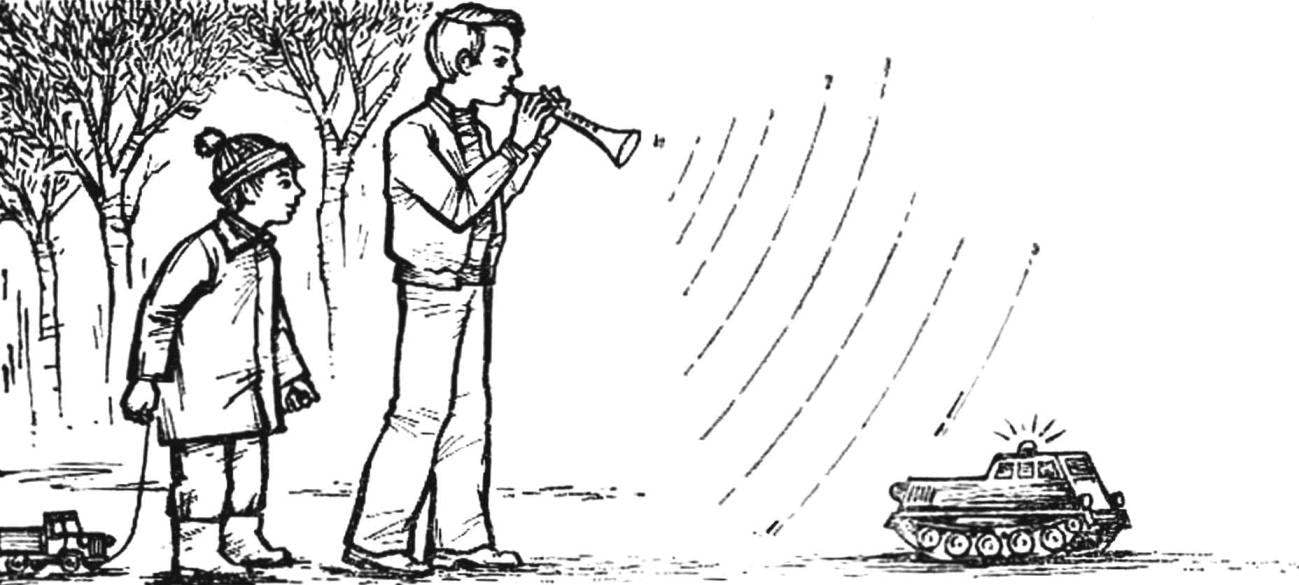Д311А diodes can be replaced by Д311, KD503 with any alphabetic index; IC К155ЛАЗ (former designation К1ЛБ553) — PA К1ЛБЭ13, К1ЛБЗЗЗ; К155ТМ2 (former designation К1ТК552) — К1ТК332. Instead of transistors МП26А fit MP20— МП21, МП25—МП26 instead КТ315Г — KT315 with any alphabetic indexes. Static current transfer ratio of all semiconductor triodes — not less than 30. Relay: K2, K4 RES9 (passport RS4.524.202 or PC4.524.215), K1. K3, K5 RES-15 (passport RS4.591.003) with a trigger voltage of 6-7 V.
Lamp type ÌÍ2,5X0,15. Switch — П2К-1-1. The motor from the electrified toys or DIT-2. Spark quenching coils have inductance at 15 µg each. On the ferrite core 600НН length 12 and Ø 2.5 mm (from the inverter circuits of radio receivers “Selga”, “Falcon”) is wound with 25 turns of wire PEV-0,35 2,
To be sure and clear the operation of the switch, they need to be checked. For this purpose the winding of the test relay is connected to the voltage source 7 and a tester, measure the resistance between the closed plates. If it is zero, this relay is suitable to work. When the contact resistance is greater than zero, remove the protective cover and clean mating surfaces.
To the negative terminal of capacitor C3 connect the audio frequency generator with the output voltage of 3 mV, a frequency of 1000 Hz. At the time of setting the ULF desolder the negative terminal of the capacitor C6, connect a millivoltmeter, setting a limit of measurement 10 V. Selecting the value of resistor R3, until the millivoltmeter readings of 2.5— 3 V. Then the resistor R6 temporarily replace a variable with a nominal value 4.7 kω and connect the tester to terminal 8 D4.4. With the variable resistor set the arrow of the tester to the mark 0,03 — 0,1 V. the relay K1 should work.
If you now disable sound generator, K1 will return to its original state. at pin 8 of element D4.4 the voltage will increase to values of 1.8 — 3 V. Replace the variable resistor at a constant, set using R1 and the desired frequency of outbreaks lamp n check the operation of the entire device 8 whole.
Fig. 2. Electrical schematic chassis model.
Fig. 3. The location of the elements of the ka receiver circuit Board.
With lamps of the type МН1Х0.068 the resistance R7 — R10 increase to 47 Ohms.
The audio receiver is suitable for any moving models driven by electric motors. Lamp features on it at any place at the option of the designer, but so that they remained constantly in the field of view of the Modeler.
Dynamic head can be set over the motor with the diffuser facing upwards and cover with a plastic spherical cap, which is made of a 20-25 hole Ø 2,5—3 mm.
A. PROSKURIN, village of Golitsyno, Moscow region.
 You obviously had to read about the models driven by sound signals. Receptor, which we offer to the reader reacts to an audio signal of a certain strength. The source may be, for example, a whistle, a whistle or sound a special transmitter commands. Equipped with this instrument model is performing in any sequence the commands: “forward”, “back”, “left”, “right”. The cessation of the audio signal or decrease it to a certain level is causing the stop model (stop). Here’s how the device works.
You obviously had to read about the models driven by sound signals. Receptor, which we offer to the reader reacts to an audio signal of a certain strength. The source may be, for example, a whistle, a whistle or sound a special transmitter commands. Equipped with this instrument model is performing in any sequence the commands: “forward”, “back”, “left”, “right”. The cessation of the audio signal or decrease it to a certain level is causing the stop model (stop). Here’s how the device works.
